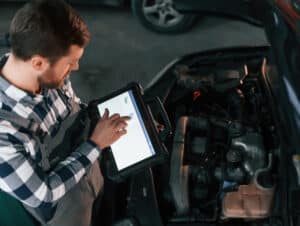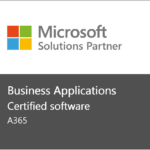Not long ago, managing a vehicle meant tracking mileage and checking for oil leaks. Today? The average car sends real-time health updates, downloads software patches in the background, and can schedule its own service appointment.
Modern vehicles are connected, intelligent, and always online. But here’s the catch: most automotive operations are not.
For importers, dealers, and fleet managers, that creates a major disconnect. The vehicles know what they need, but your systems might not. And if you can’t speak the same digital language as the brands you represent, you’re always one step behind.
Let’s get real: Where the pain points show up
Picture this.
You’re a service manager at a multi-brand dealership. A customer drops off their vehicle after receiving a “check engine” notification. You log in, search for the latest service bulletin, confirm the VIN, check warranty status, and finally start diagnosing.
Meanwhile, the OEM already knows the issue, has issued an over-the-air fix, and flagged the vehicle for a campaign you didn’t even know about.
Now multiply that by 20 customers a day.
That’s not just inefficient. It’s a frustrating experience for staff and customers alike. And it’s not your team’s fault. It’s the system.
Disconnected systems mean delayed decisions, frustrated technicians, and missed opportunities.
Integration is no longer a luxury. It’s the cost of staying competitive
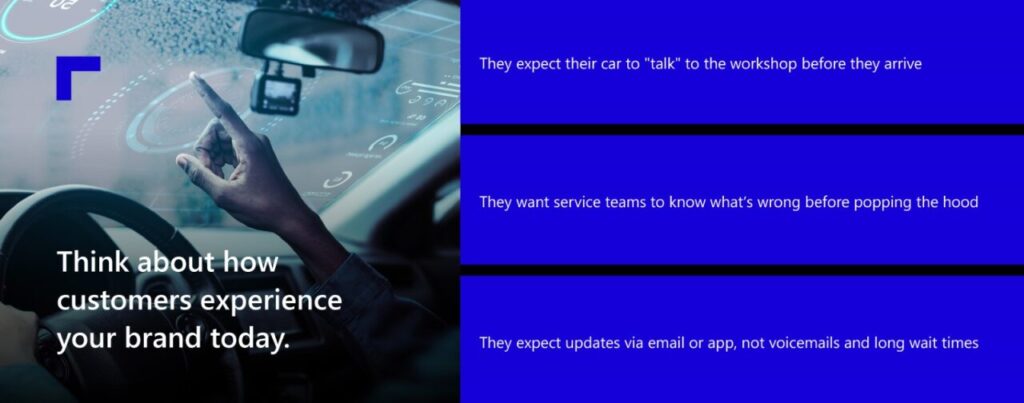
And guess what? OEMs have already built the digital infrastructure to support all of this. The question is: Are your systems integrated into that ecosystem?
If not, you’re stuck relying on:
- Manual data entry
- Outdated repair guides
- Warranty claim guesswork
- Spreadsheets and scattered communication
That may have worked five years ago. Today, it’s a serious bottleneck.
What does a connected operation look like?
When your business is plugged into the brand ecosystem, everything changes.
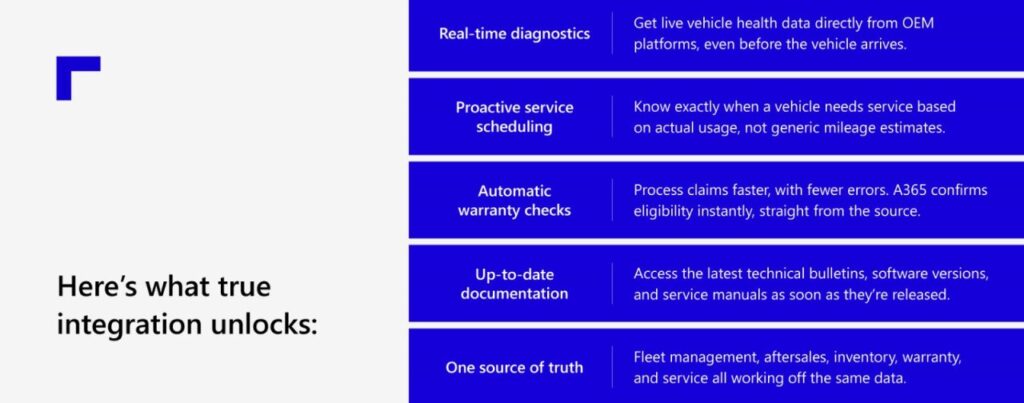
This is more than automation. It’s alignment between you, your customers, and the OEMs you represent.
Enter A365: built for automotive. Ready for what’s next.
A365 is Annata’s purpose-built platform for the automotive industry.
It’s built on Microsoft Dynamics 365, Azure, Copilot, Power Platform, and Dataverse, and integrates natively with leading automotive brand systems.
More importantly, it’s shaped by real-world challenges from dealers, importers, and mobility providers across the globe.
So what makes A365 different?
- Built to speak OEM language
A365 was designed from the ground up to sync with OEM platforms, so you’re not stuck building custom integrations for every new model or update.
It handles the tough stuff for you:
- Vehicle connectivity
- Warranty validation
- Campaign and recall tracking
- Remote diagnostics
- Software version syncing
When a vehicle gets smarter, so does your system.
- Designed for the realities of automotive operations
This isn’t generic ERP dressed up in industry terms. A365 reflects the workflows, challenges, and complexity of modern automotive businesses, including:
- Multi-brand environments with different standards and systems
- VIN-level traceability across sales, service, and warranty
- Importer workflows like homologation, fleet prep, and vehicle configuration
- Retail needs like technician scheduling, service quotes, and parts management
Whether you run 10 dealerships or manage 100,000 vehicles, A365 scales with you.
- Seamless Microsoft ecosystem integration
A365 fits right into your existing Microsoft environment:
- Microsoft Dynamics 365 for CRM, finance, and operations
- Power BI for deep, customizable analytics
- Microsoft Teams for service communication and collaboration
- Power Automate and Copilot for intelligent workflows and AI-driven insights
Your data flows securely, and your teams stay productive with tools they already know.
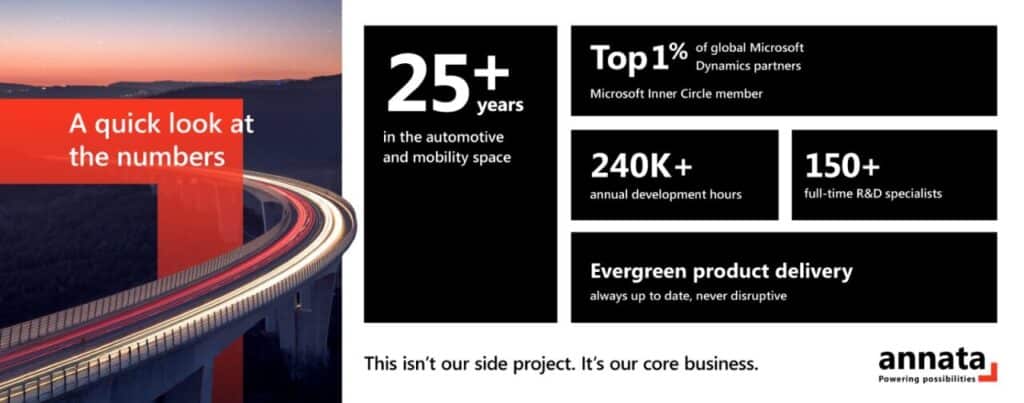
A scenario you know all too well
Let’s say you’re managing a fleet of electric vehicles for a last-mile delivery company.
One of your drivers notices reduced battery performance. You schedule a manual check, log the issue in a spreadsheet, and ask the service center to investigate.
Meanwhile, the OEM platform already detected the issue, issued a service bulletin, and released a patch. But your team doesn’t know because your systems aren’t talking.
With A365, the service alert would have shown up the moment the issue occurred. You could’ve scheduled proactive service, updated the driver, and ensured minimal disruption.
That’s the difference between reactive and proactive. And your customers can feel it.
Why the right integration platform matters
Brand integrations aren’t “one and done.” OEM systems evolve constantly with new models, protocols, and software.
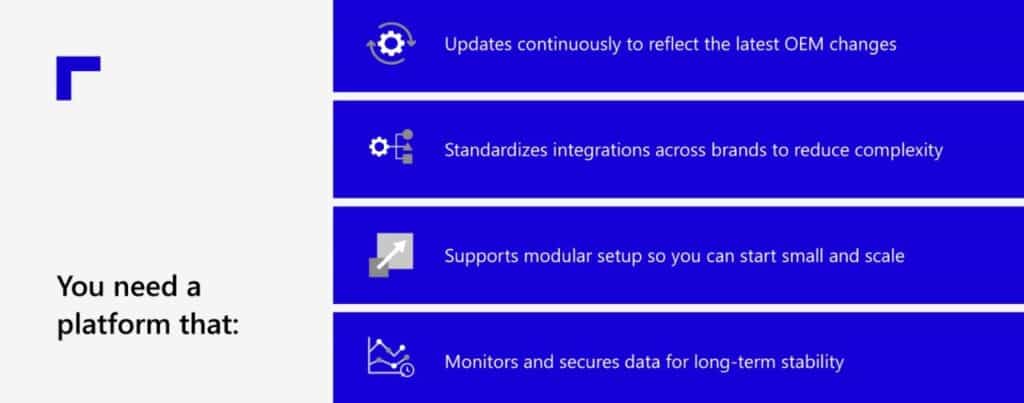
That’s what A365 delivers without hidden headaches or endless customization.
Making OEM integrations work for you
When you manage a modern vehicle operation, whether you’re importing, selling, or servicing, you’re not just dealing with cars. You’re working inside a digital ecosystem, where everything from diagnostics to software updates flows through OEM platforms.
That’s why seamless OEM integration is how you stay aligned, connected, and competitive.
This is exactly where Annata comes in.
OEM integrations without the complexity
Integrating with OEM systems can get complicated quickly. Different protocols, constant updates, and limited internal resources often turn what should be simple into a time-consuming challenge.
Annata takes that burden off your shoulders.
We’ve built OEM integrations directly into A365 and Microsoft Dynamics 365, so you don’t have to start from scratch. We make it easy to connect, sync, and run everything in one place.
Built for the real world and the road ahead
We’ve delivered integrations across global brands and markets, and we know success doesn’t stop at go-live. That’s why we built a specialized OEM integration team inside Annata.

Standard where it counts. Flexible where it matters.
No two OEMs operate the same way. But that doesn’t mean every integration has to start from zero.
Our integration packages follow a modular, standardized structure. That means we can move faster while still adapting to your unique needs. Whether you are working with one OEM or several, A365 adjusts without overcomplicating your setup.
A smarter integration lifecycle
We treat integration as a long-term strategy, not a one-time task.

Support that stays with you
Integration is not just about setup. It is about keeping things running smoothly after launch.

Our team is with you, before, during, and after deployment.
Less friction, more compatibility
A365 is built on standardized models and protocols, so your systems talk clearly to OEM platforms.
This means:
- Fewer mismatches or errors
- Cleaner, more consistent data
- Less manual work
You get smoother operations and fewer headaches.
Ready for what comes next
OEM platforms are always evolving. From EV systems to remote software updates, your integration needs will keep growing.
A365 is built to keep up. We continuously update integrations to match the latest OEM tech and standards so you can lead, not lag.
Let’s make it simple
Tired of disconnected tools and scattered data? Annata is here to help.
OEM integration should be simple, scalable, and aligned with your business.
With A365, it is.
Let’s build a smarter foundation together.
Step into your personalized Digital Experience Center and explore how A365 can drive your success.
Enter your email address to get started. Your custom experience room will be created instantly. It’s completely free.








